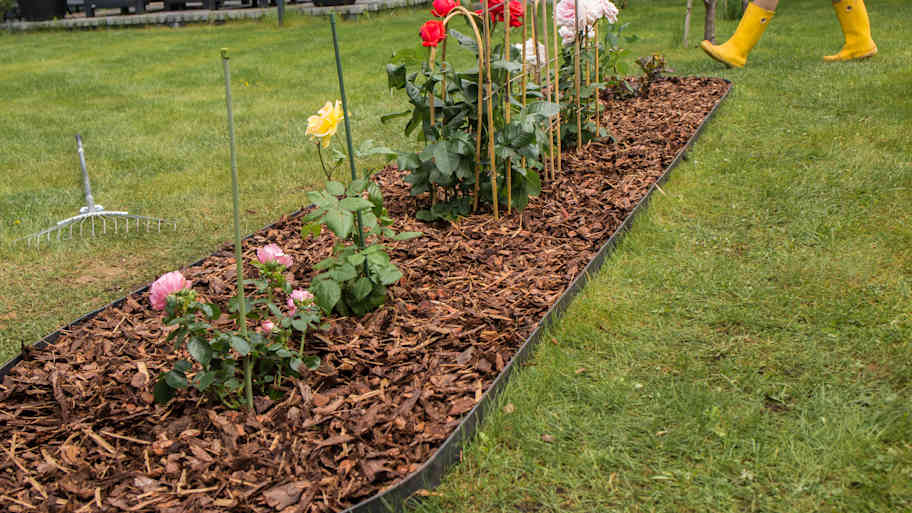
Find out how much a soil test costs and what you get for your money with our expert guide. Know what to budget for different types of soil tests.
Here’s how to become your own mulch master


Mulch has an abundance of benefits. It reduces weed growth, maintains soil moisture, regulates soil temperature and adds aesthetic appeal. To make the most of your mulch, we’ve developed a guide on how to lay mulch to take advantage of its benefits and enjoy its look.
Before diving into laying mulch, it’s important to note that there are different types of mulch to choose from. The type of mulch you opt for depends on what kind of project you’re tackling. For instance, a vegetable garden could benefit from bark or wood chips, while colored mulch may be better suited for a flowerbed. Additionally, if you’re able to choose a day to complete the task, a sunny, warm day will be easier and more comfortable for you to complete it.
The first step in laying mulch is to prepare the bed where you will be spreading the mulch by removing debris and tidying plants. You should remove dried up leaves and sticks and prune diseased and dead branches from other plants and trees, and pinch off any dead parts of perennial or annual flowers. Finish this step by tidying the edges of the bed. To do this, you can use a shovel or spade to draw a defined line between the bed and your lawn.
If the bed is dry—say there hasn’t been any recent rain—you’ll want to water it before you spread new mulch. Since mulch helps seal in moisture, you want to set up the bed for the opportunity to retain valuable moisture.
Just because mulch suppresses weed growth, doesn’t mean that removing weeds shouldn’t be a part of how to spread mulch. By removing pre-existing weeds before you lay the fresh mulch, you’re creating optimal conditions for the soil and plants to come.
Shovel the mulch from your wheelbarrow onto the bed, or shake the mulch directly onto the soil from the bag, into small piles. It’s especially important to make sure you apply mulch around the base of any plants in the bed to protect them.
Once you have the amount of mulch you need, spread it evenly across the bed using your hands—make sure to wear gardening gloves to protect your hands from getting scratched by debris.
While the mulch cost will go up the more you need to use, you don’t want to skimp out and have it be uneven. It will probably take a couple layers of mulch to cover the entire bed, depending on its size. So keep shoveling or shaking out piles of mulch onto the bed and spread accordingly as you go.
The final step in how to lay mulch is to check its depth to ensure you have an adequate amount before moving on.
As previously mentioned, how much mulch you need depends on the size of your bed. However, when it comes to the mulch’s depth, the rule of thumb is pretty universal. To deter weeds from invading your soil, the mulch needs to be about three-inches deep. If you can see bare soil poking through the mulch, you need to add more.
Spreading mulch is a very doable task–even for beginner DIYers. When you do it on your own, you cut down on landscaping costs by only needing to buy supplies, and perhaps any gardening tools you don’t already own, instead of also needing to pay for labor and for the delivery of the mulch.
That being said, if you’re running short on free time, don’t feel you can do this task safely on your own, or if the project at hand is large enough to go beyond the DIY-scope, you can seek out the cost of mulch delivery near you and browse potential pros to tackle the landscaping on your behalf.
From average costs to expert advice, get all the answers you need to get your job done.

Find out how much a soil test costs and what you get for your money with our expert guide. Know what to budget for different types of soil tests.

Find out the average mulch delivery and installation cost, plus key factors that impact your price. Learn how to budget, compare options, and save on your landscaping project.

Discover the average sand delivery cost, key price factors, and tips to save on your next project. Get transparent, up-to-date estimates for sand delivery.

Knowing who to hire for mulch installation can seem tricky at first. Read this guide to figure out which companies are your best options for a mulching project.

Not sure whether to use black or brown mulch? Learn how each type affects your soil, plants, and garden style so you can pick the right fit.

Forestry mulching is one of the most effective ways to clear acres of land. While it’s relatively cheap, it may not be the best solution for everyone.